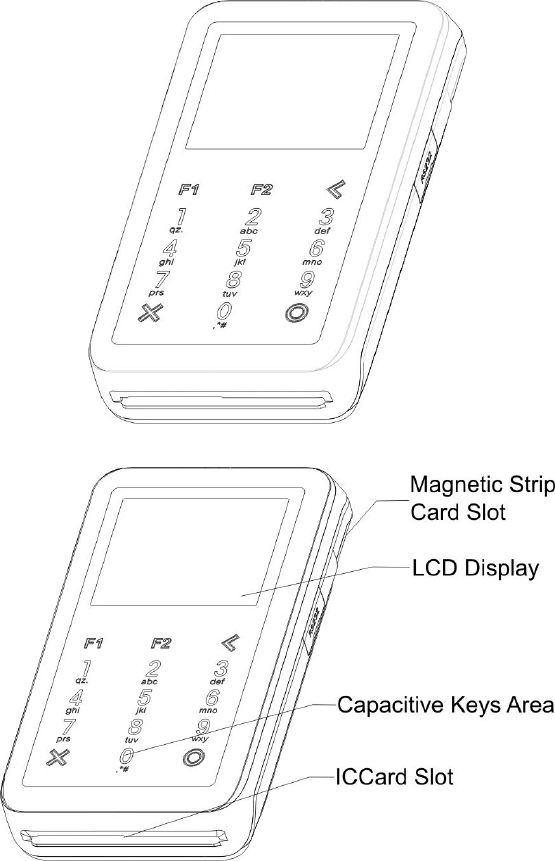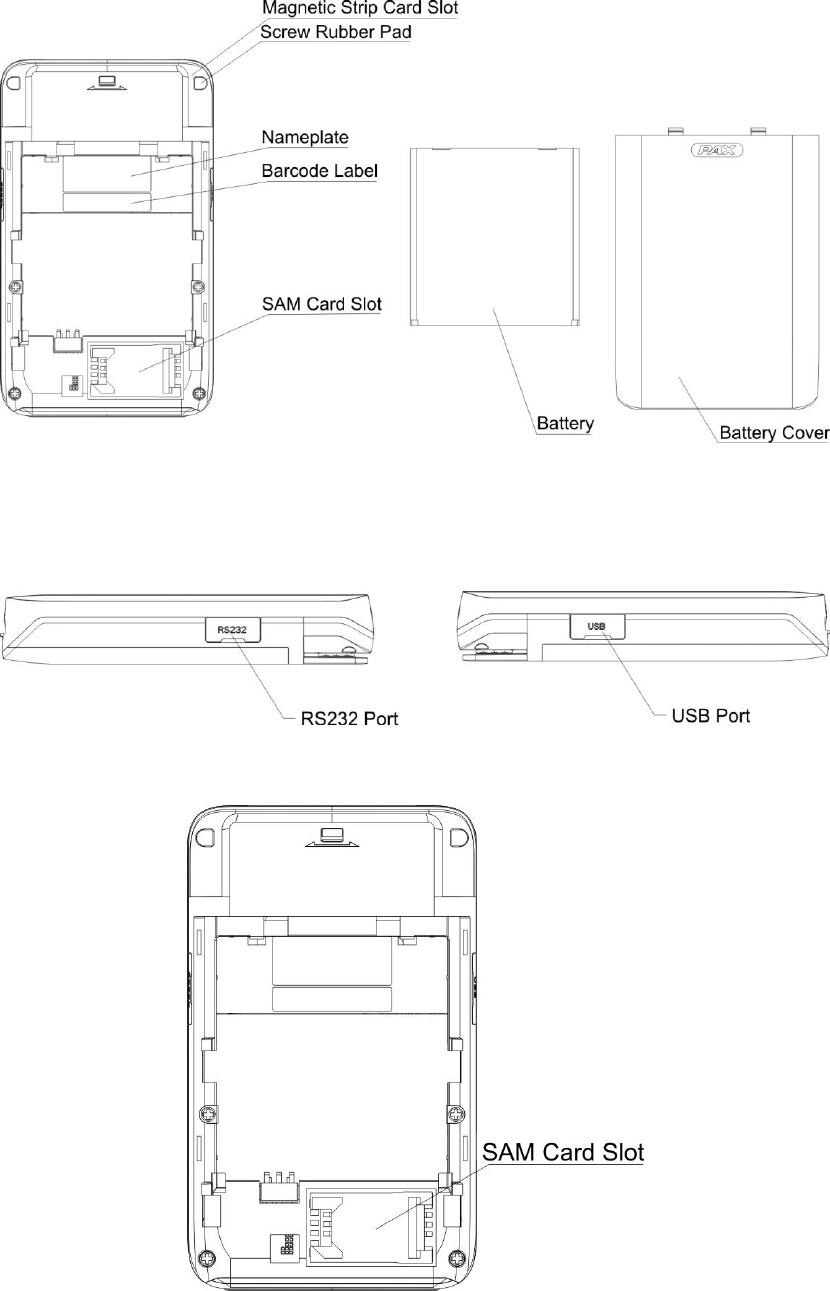PAX Technology D200W Wireless POS Terminal User Manual
PAX Technology Limited Wireless POS Terminal
User manual

D200 Wireless POS Terminal
1. Production Description:
TOP View

Bottom View
Side Socket View
SAM Slot Area

2. Installation
1) SAM Card Installation
① Open up battery cover, which is at the bottom of the terminal;
② Take out battery;
③ Insert SAM card to corresponding SAM card slot.
2) Battery Installation
① Hold the battery with its facing up;
② Attach battery forelock to battery bayonet;
③ Press down the other side of the battery
3. Instruction
1) Power ON/OFF
Power on: Insert power adapter or insert the battery, Press button for 3 seconds until LED
backlight is on. If POS terminal is being turned on successfully, PAX LOGO can be seen and
‘Di’ from the buzzer can be heard.
Power off: Press button for 3 seconds until Shutting down... can be seen. POS terminal is
being turned off.
2) Magnetic Stripe Card
When user swipes magnetic stripe card along the slot, the backside of card, which contains
magnetic strip information, should be facing to the terminal. Bi-directional swiping is supported. It
is recommended to swipe starting from the top of the terminal to the bottom of the terminal with a
constant moving speed.
3) IC card
When user insert IC card into the IC slot, the chip of IC card should be facing up; user is
recommended to gently insert the card, in order to avoid any physical damage to the card or the IC
slot of the terminal. If IC card is successfully read by the terminal, the IC card icon will be shown
on LCD display screen.
4. Specifications
Default
Contactless Card Reader
CPU: 32-bit,MIPS
Memory:32MB SDRAM , 32MB NOR Flash
Display:2.4 -inch 240x320 pixel color TFT LCD;LED backlight;
Keypad:10 alphanumeric keys, 5 functional keys,touch key;
Magnetic Card Reader :Track 1/2/3,bi-directional swipe
IC Card Reader:1 user card (EMV2000)
SAM slots:SAM slot
1
Communication:Bluetooth, WIFI
Peripheral Ports: 1 Micro USB(Device)
1 Mini USB(RS232)
Power Supply:Input:100—240VAC ~0.2A 50/60HZ
Output:5V DC 1A
Battery:Li-on bttery,1900mAh,3.7V
Working Environment: Temperature:0 ℃~50℃(32℉~122℉)
R.H.:10%~93%(non-condense)
Storage Environment: Temperature:-20℃ ~ 70℃ (-4℉~158℉)
R.H.:5% ~95%(non-condense)
Dimensions:120mm
72mm
22.1mm(L
W
H)
Weight:165g
5. Installation and Usage Tips
1)Do not damage electric wire and power adapter. If electric wire or power adapter is damaged ,
please do not use the terminal any more.
2) Before power adapter is plugged into power socket, please make sure that voltage which the
power socket supplies is appropriate working voltage for the terminal.
3)Do not expose the terminal in sunshine, or in humid, hot, or dusty environment
4)Keep the terminal away from liquid material
5) Do not plug any unknown material into any port of the terminal, since it may create serious
damage to the terminal.
6) If the terminal is defective, please contact professional POS repair technicians.
7) When installing paper roll, please be aware of the cutter within paper bracket.
8)When D200 power supplied by the USB port of PC,we don’t recommend the use of CTLS
function.
9)When charged by the USB port of PC, charge time will be long, we recommend charging using
the adapter.
6.Battery Usage Tips
1) Charge indoor by PAX charger, where is cool and well ventilated;
2) Do not apart the battery;
3) Do not short circuit the battery;
4) Keep the battery away from sunshine, smog and dust;
5) Do not squeeze, punch the battery, put it into liquid or near fire;
6) Keep way from environment which is too hot , too cold, damp and highly explosive;
7) Once a failure happens such as heating or distortion, or it was broken down. Please change new
battery;
8) Change new battery if it cannot satisfy your requirement;
9) Change new battery if using more than two years.
7. FCC Regulations:
This mobile phone complies with part 15 of the FCC Rules. Operation is subject to the following
two conditions: (1) This device may not cause harmful interference, and (2) this device must
accept any interference received, including interference that may cause undesired operation.
This mobile phone has been tested and found to comply with the limits for a Class B digital device,
pursuant to Part 15 of the FCC Rules. These limits are designed to provide reasonable protection
against harmful interference in a residential installation. This equipment generates, uses and can
radiated radio frequency energy and, if not installed and used in accordance with the instructions,
may cause harmful interference to radio communications. However, there is no guarantee that
interference will not occur in a particular installation If this equipment does cause harmful
interference to radio or television reception, which can be determined by turning the equipment off
and on, the user is encouraged to try to correct the interference by one or more of the following
measures:
-Reorient or relocate the receiving antenna.
-Increase the separation between the equipment and receiver.
-Connect the equipment into an outlet on a circuit different from that to which the receiver is
connected.
-Consult the dealer or an experienced radio/TV technician for help.
FCC Note:
Caution: Changes or modifications not expressly approved by the party responsible for
compliance could void the user‘s authority to operate the equipment.
8. RF Exposure Information (SAR)
This phone is designed and manufactured not to exceed the emission limits for exposure to radio
frequency (RF) energy set by the Federal Communications Commission of the United States.
During SAR testing, this device was set to transmit at its highest certified power level in all tested
frequency bands, and placed in positions that simulate RF exposure in usage against the head with
no separation, and near the body with the separation of 0 mm. Although the SAR is determined at
the highest certified power level, the actual SAR level of the device while operating can be well
below the maximum value. This is because the phone is designed to operate at multiple power
levels so as to use only the power required to reach the network. In general, the closer you are to
a wireless base station antenna, the lower the power output.
The exposure standard for wireless devices employing a unit of measurement is known as the
Specific Absorption Rate, or SAR. The SAR limit set by the FCC is 1.6W/kg.
This device is complied with SAR for general population /uncontrolled exposure limits in
ANSI/IEEE C95.1-1992 and had been tested in accordance with the measurement methods and
procedures specified in IEEE1528. This device has been tested and meets the FCC RF exposure
guidelines when tested with the device directly contacted to the body.
The FCC has granted an Equipment Authorization for this model phone with all reported SAR
levels evaluated as in compliance with the FCC RF exposure guidelines. SAR information on
this model phone is on file with the FCC and can be found under the Display Grant section of
www.fcc.gov/oet/ea/fccid after searching on FCC ID: V5PD200W.
For this device, the highest reported SAR value for usage near the body is 0.01 W/kg.
While there may be differences between the SAR levels of various phones and at various positions,
they all meet the government requirements.
SAR compliance for body-worn operation is based on a separation distance of 0 mm between the
unit and the human body. Carry this device at least 0 mm away from your body to ensure RF
exposure level compliant or lower to the reported level. To support body-worn operation, choose
the belt clips or holsters, which do not contain metallic components, to maintain a separation of 0
mm between this device and your body.
RF exposure compliance with any body-worn accessory, which contains metal, was not tested and
certified, and use such body-worn accessory should be avoided.